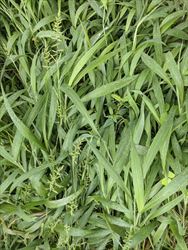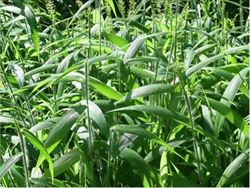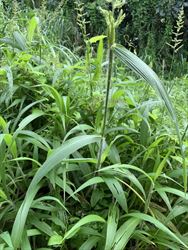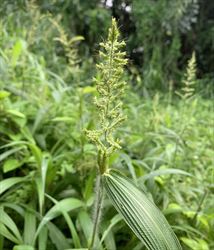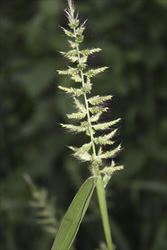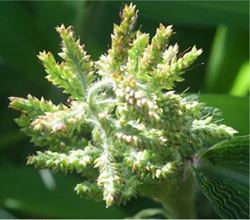Bristly foxtail grass; it is also known as corn grass, East Indies foxtail grass, Mary grass.
Pacific Pests, Pathogens, Weeds & Pesticides - Online edition
Pacific Pests, Pathogens, Weeds & Pesticides
Bristly foxtail grass (508)
Setaria barbata. Previously, it was known as Chaetochloa barbata and Panicum barbatum. It is a member of the Poaceae.
Asia, Africa, North (Florida), South and Central (Panama) America, Caribbean, Oceania. It is recorded from Australia (Queensland, but naturalisation is in doubt), Fiji, French Polynesia, New Caledonia, Papua New Guinea, Samoa, Solomon Islands, and Tonga.
An invasive, annual plant, occurring in crops and along roadsides in damp, disturbed, shaded places often sprawling or scrambling on shrubs in thickets, forest clearings, and plantations (Photos 1&2). Reported a weed of orchards, vegetables, root crops, banana, sugarcane, and tea plantations. Occurs from sea level to several hundred metres (500-600 masl, but lower in Fiji).
Bristly foxtail grass has erect stems, up to 2 m tall, arising from broad clumps. Leaves are dark green, spear-shaped, (up to 30 cm long), broad (up to 30 mm), pointed at the top, very wrinkled, and covered with short soft hairs on both sides (Photos 3&4). The ligule - the membrane between the leaf and stem - is a line of short hairs. The inflorescence (collection of flowers) up to 25 cm with horizontal branches (up to 5 cm) and spikelets of two egg-shaped flowers (2.5-3 mm) along its length (Photos 5&6). Each spikelets is supported by a bristle about 10 mm long. The roots are fibrous, some originating from the lower nodes.
Spread occurs slowly from roots developing on lower stems, and more rapidly by seed on machinery - during mowing, slashing and cultivation - and fur of animals and on clothes. Long distance spread is presumably as a contamination of seed of other crops.
There are reports of serious, up to 30%, infestation in cultivated land, with up to 50% in sugarcane in Reunion. In Seychelles, an important weed of orchard, vegetables, roots crops, and in banana and tea plantations.
It is used as a fodder grass for livestock, especially for horses and donkeys, although the bristles can irritate. Useful in both wet and dry seasons. Said to be used in massages for epileptic, and other (neurological) disorders.
BIOSECURITY
There is a high risk of introduction of this weed. Countries not yet infested by Setaria barbata should consider all likely pathways for entry, and apply quarantine measures accordingly. Particular attention should be given to the likelihood that seed of the grass is a contaminant of seed of other crop species.
BIOLOGICAL CONTROL
No information available.
CULTURAL CONTROL
- Physical & Mechanical:
- Hand weeding (and hoeing) is effective on small areas where follow-up is possible to control seedlings.
- Slashing will slow growth, but not prevent it; note, stems pieces will root and form new plants.
- Hygiene:
- Treat vehicles and farm machinery. If moving from areas where the weed occurs to those weed-free, wash to remove soil and seed. This is equally important if the machinery is being imported into a country or moved within a country.
- Fodder:
- Make sure hay brought into clean areas is free of bristfle foxtail grass.
CHEMICAL CONTROL
In Australia, several herbicides are registered for the control of Setaria species growing in a range of crops (https://apvma.gov.au/), including: butroxydim; glufosinate-ammonium; haloxyfop-P; oxyfluorfen; S-metolachlor; quizalofop-P-ethyl; pendimethaline. In Fiji, glyphosate.
--------------------
Note, EU approval to use glyphosate ends in December 2022; its use after that date is under discussion.
____________________
When using a pesticide, always wear protective clothing and follow the instructions on the product label, such as dosage, timing of application, and pre-harvest interval. Recommendations will vary with the crop and system of cultivation. Expert advice on the most appropriate herbicides to use should always be sought from local agricultural authorities.
AUTHORS Grahame Jackson & Makereta Ranadi
Information from weeds of Fiji. Department of Agriculture Bulletin No.35: 73-74; and Parham JW (1955) The grasses of Fiji. Suva. Government Press; and WIKITROP - Weed identification and knowledge in the tropical and Mediterranean areas (https://portal.wiktrop.org/species/show/291); and AUSGrass2. Grasses of Australia. (https://ausgrass2.myspecies.info/content/setaria-barbata); and (including Photos 3&4 - copyright to Setaria barbata - Sungei Tengah Rd, Singapore. pizzamurderer(CC)) Setaria barbata (Lam.) Kunth. Plants of the world online. Royal Botanic Gardens, Kew. (http://www.plantsoftheworldonline.org/taxon/urn:lsid:ipni.org:names:1172068-2); and from Setaria barbata Kunth., Poaceae. Pacific island ecosystems at risk (PIER). (http://www.hear.org/pier/species/setaria_barbata.htm). Photo 1 Vengolis FloraKozhikode. Wikimedia Commons.(https://commons.wikimedia.org/wiki/File:Setaria_barbata_20181121_102537.jpg). Photo 5 Marco Schmidt. Setaria barbata, F.Cl. de Pahou, Benin. Wikimedia Commons. (https://commons.wikimedia.org/wiki/File:Setaria_barbata_MS6822.jpg).
Produced with support from the Australian Centre for International Agricultural Research under project HORT/2016/185: Responding to emerging pest and disease threats to horticulture in the Pacific islands, implemented by the University of Queensland, in association with the Pacific Community and Koronivia Research Station, Ministry of Agriculture, Fiji.
